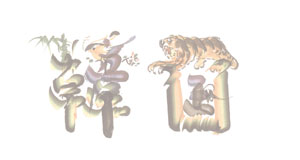 | ||
Hyeok pil-hwa is a picture painted with a leather brush. Although it is often said that Yu Duek-gong, a scholar of Chinese classics of the 18C, started this novel art, the genuine history of hyeok pil-hwa is that it took the motif of Yu's unique style of handwriting, Bi Baek-seo. The creator of hyeok pil-hwa is not known, but when and how it started are certain. Started in the 1930s' during the Korean industrialization period, it gained popularity. During the Korean War, hyeok pil-hwa became more popular and surging refugee painters started to make a living out of it. This phenomenon continued till the 1960s when the demands of hyeok pil-hwa decreased rapidly.
Hyeok pil-hwa was derived from mun ja-do, another folk painting. Korean folk painting started from the 18C in the Joseon Dynasty by anonymous painters, to express the sentiment of the common people. Mun ja-do, a picture expressing a Chinese character and the Confucian ideas on, was one of these folk paintings. This, however, required a lot of work and time since it treated characters dealing with Confucian ideas, which were mixed up with drawings of various creatures. Thus, a faster and easier way of drawing mun ja-do has been invented, which was hyeok pil-hwa. In the beginning, Hyeok pil-hwa acted as an assisting role of mun ja-do. However, as it got popular among people, it began its independent way and consequently gained even more popularity than its mother.
Being a great time saver, which was desperately needed in the modern society, hyeok pil-hwa gradually spread throughout the nation regardless of the social status of the customers. It became more convenient since its colors were even more brighter and livelier than mun ja-do, despite the short time it took. As hyeok pil-hwa itself struggled to attract people's attention, it became more and more gorgeous and the role of drawings became more important than mun ja-do. While the drawings were simply decorations to emeuorate the characters in mun ja-do, the drawings in hyeok pil-hwa were united with the character, and also independent. As it was both artistic and convenient, hyeok pil-hwa gained popularity in the industrial society, unlike many other heritages that became obsolete in this era. However, with the development of the printing industry, it disappeared in our daily lives.
Although hyeok pil-hwa had almost disappeared in the minds of Koreans, it has found its own way to survive beyond their eyes. Many painters continue painting hyeok pil-hwa in Insa-dong or at national sports events, that attracts the eyes of foreigners. They try to internationlize hyeok pil-hwa by using characters of various nations. Unfortunately, although it gives deep impressions to its spectators, hyeok pil-hwa has gradually become a disappearing art form. "Hyeok pil-hwa is a heritage of two aspects: a performance and a drawing. It does not have a long history, but with its modern characteristic of utility, we could make good use of it nowadays," says Kang Wan-joo, a pictorial calligrapher.
Hyeok pil-hwa is a heritage that possesses the practical wisdom of our ancestors. Many Koreans, however, do not know what hyeok pil-hwa is and even if they do, they think of it as a Chinese heritage. As it can be seen in events such as the Olympics or the Asian games, hyeok pil-hwa it is more popular among foreigners than Koreans themselves. Although it is not recognized by its own people, hyeok pil-hwa is one of Korea's valuable treasures. To acknowledge the heritages of their country, including hyeok pil-hwa, it is essential that Koreans recognize their own culture and be proud of it.
 | ||
Kim Hee-won Assisstant Reporter
yazawa@yonsei.ac.kr

